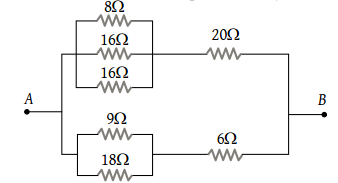The equivalent resistance of the arrangement of resistances shown in adjoining figure between the points A and B is

1. 6 ohm
2. 8 ohm
3. 16 ohm
4. 24 ohm

In the network of resistors shown in the adjoining figure, the equivalent resistance between A and B is
1. 54 ohm
2. 18 ohm
3. 36 ohm
4. 9 ohm
A wire is broken in four equal parts. A packet is formed by keeping the four wires together. The resistance of the packet in comparison to the resistance of the wire will be
1. Equal
2. One fourth
3. One eight
4.
In the given figure, when key K is opened, the reading of the ammeter A will be
1. 50 A
2. 2 A
3. 0.5 A
4.
If a resistance R2 is connected in parallel with the resistance R in the circuit shown, then possible value of current through R and the possible value of R2 will be
1.
2.
3.
4.
A battery of emf \(10\) V is connected to resistance as shown in the figure below. The potential difference \(V_{A} - V_{B}\)
between the points \(A\) and \(B\) is:

1. \(-2\) V
2. \(2\) V
3. \(5\) V
4. \(\frac{20}{11}~\text{V}\)
A student has 10 resistors of resistance ‘r’. The minimum resistance made by him from given resistors is :
1. 10 r
2.
3.
4.
Two wires of same metal have the same length but their cross-sections are in the ratio 3 : 1. They are joined in series. The resistance of the thicker wire is 10 Ω. The total resistance of the combination will be
1. 40 Ω
2.
3.
4. 100 Ω
The equivalent resistance of the following infinite network of resistances is
1. Less than 4 Ω
2. 4 Ω
3. More than 4 Ω but less than 12 Ω
4. 12 Ω
In the figure given below, the current passing through 6 Ω resistor is
1. 0.40 ampere
2. 0.48 ampere
3. 0.72 ampere
4. 0.80 ampere











